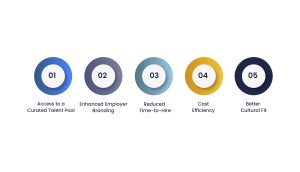The Future of Recruitment: Using Direct Sourcing to Address Global Talent Gaps

Building an effective global talent acquisition strategy to drive innovation and growth has become increasingly challenging. In an era where digital transformation, emerging technologies, and evolving business models are reshaping industries, companies must secure the right talent to remain competitive.
However, the rising talent shortage is making this a challenging task, particularly in highly specialised sectors like technology, healthcare, and engineering. Organisations across the globe are grappling with these shortages, with the competition for skilled professionals more intense than ever.
The talent war is real—and businesses need to rethink their recruitment strategies to ensure they are attracting, retaining, and engaging the best candidates. One approach that is gaining significant attention in overcoming these recruitment challenges is direct sourcing. This method, which involves sourcing candidates directly from talent pools and networks, is showing promising results for organizations struggling to fill hard-to-find roles. But is direct sourcing the right solution for every company?
The Talent Shortage Crisis

The demand for skilled professionals in specialised fields is growing faster than the supply. This is particularly true in areas such as:
Technology: As digital transformation accelerates, the need for data scientists, software engineers, and cybersecurity experts has skyrocketed.
Healthcare: From doctors and nurses to medical researchers and healthcare administrators, there is an ongoing shortage of skilled healthcare professionals.
Engineering: Highly specialised roles in industries like aerospace, construction, and manufacturing continue to experience significant talent gaps.
While these shortages affect every sector, their impact is particularly severe in industries that rely on highly skilled, niche professionals. The global economy’s shift toward technology, innovation, and data-driven decision-making only magnifies this issue. As a result, traditional recruitment models, which often rely on job boards, recruitment agencies, and word of mouth, are struggling to keep pace with the demand. Businesses that fail to adapt their hiring strategies risk missing top talent and falling behind their competitors.
What is Direct Sourcing?

Direct Sourcing is a recruitment method in which companies take control of their hiring process by sourcing candidates directly from talent pools, job boards, or even social media platforms. Rather than relying on third-party recruitment agencies, direct sourcing allows organisations to tap into existing networks of candidates, often engaging with passive candidates who may not be actively job-hunting but are open to new opportunities.
Direct sourcing allows companies to build their own curated, in-house talent pools, ensuring they can always access high-quality candidates when needed. It also involves nurturing relationships with candidates over time, so businesses can tap into a ready pool of qualified professionals whenever a suitable position arises.
But as effective as direct sourcing can be, it is important to assess whether it is the right fit for your organisation.
The Benefits of Direct Sourcing for Hard-to-Fill Roles

For organisations struggling with talent shortages, direct sourcing offers several advantages:
Access to a Curated Talent Pool: Direct sourcing allows companies to build and maintain a pool of pre-vetted candidates who have been assessed for skills and cultural fit. This ensures that qualified candidates are readily available when a position opens.
Enhanced Employer Branding: With direct sourcing, companies can leverage their brand to attract talent. This approach allows them to communicate their values, work culture, and employee benefits directly, often resonating better with candidates than third-party recruiters.
Reduced Time-to-Hire: Having a direct talent pool means that the hiring process can be expedited significantly. Candidates who have already been assessed and approved can be contacted as soon as there is an open position, reducing the time required to fill a role.
Cost Efficiency: By building an internal talent pipeline, companies can reduce reliance on external agencies, saving on placement fees and other recruitment costs. Over time, this strategy can lead to significant cost reductions in recruitment.
Better Cultural Fit: Direct sourcing enables companies to focus on candidates who are aligned with the organisation’s culture and values, often resulting in better long-term retention and a stronger overall team dynamic.
How Direct Sourcing Stands Out Compared to Traditional Recruitment Models?
When it comes to hard-to-fill roles, traditional recruitment strategies often fall short. The reliance on external recruiters or agencies can result in inflated costs, longer hiring cycles, and limited control over the candidate experience. In contrast, direct sourcing provides a more flexible and proactive approach. Traditional recruitment models focus on filling open positions as they arise, leading to reactive hiring. Direct sourcing, however, shifts the focus to building a proactive talent strategy. By nurturing a pool of candidates before positions even become available, direct sourcing allows companies to be more strategic and selective.
Another key difference is the level of engagement. Direct sourcing emphasizes creating long-term relationships with candidates, which leads to a higher likelihood of retention. For roles that require specialised skills and in-depth organisational knowledge, this long-term engagement can be highly advantageous.
Steps to Implement a Global Direct Sourcing Strategy

Building a global direct sourcing strategy for hard-to-fill roles requires careful planning and investment. Below are the key steps:
Define Target Talent Profiles: Identify the roles that are most difficult to fill and establish a clear profile for each position. This includes outlining required skills, experience, and location-based requirements.
Leverage Technology for Candidate Sourcing: Use advanced platforms and AI-based tools to reach a wider audience and identify candidates who meet the desired profiles. These technologies can also help filter candidates, matching them more precisely to specific roles.
Build and Nurture Talent Communities: Establish ongoing relationships with potential candidates by creating a community around your brand. This can be achieved through social media, targeted communications, and networking events.
Implement a Strong Employer Branding Strategy: Employer branding is essential to a successful direct sourcing approach. Highlight the unique benefits of working with your organisation, such as flexibility, career growth opportunities, and global exposure.
Engage with Passive Candidates: For hard-to-fill roles, passive candidates — those who are not actively looking for a new job — are often highly suitable. Reach out to these individuals through personalised messaging and engagement tactics, making them aware of potential future opportunities.
Establish Clear Metrics and Analytics: Track and measure the effectiveness of your direct sourcing strategy. Metrics such as time-to-fill, cost-per-hire, and candidate satisfaction can provide valuable insights into how well your approach is working and where it might need adjustments.
Conclusion: Is Direct Sourcing the Answer to Hard-to-Fill Roles?
Direct sourcing is not a one-size-fits-all solution, but for many organisations, it offers a powerful way to address the challenges of global talent acquisition. By taking control of the talent acquisition process, companies can tap into new sources of talent, reduce costs, and enhance the quality of their hires. For hard-to-fill roles, direct sourcing provides a targeted approach that aligns with both short-term and long-term hiring goals. It allows organisations to build relationships with potential candidates and improve the candidate experience, leading to higher retention rates and a stronger talent pipeline. However, to succeed with direct sourcing, companies must be willing to invest in technology, maintain an active engagement strategy, and comply with international hiring regulations.
With the right resources and commitment, direct sourcing can be a valuable solution in the global talent acquisition strategy for hard-to-fill roles, enabling companies to stay competitive and future-proof their workforce. In the quest for global talent, direct sourcing stands out as a strategic approach that goes beyond traditional recruitment methods. It empowers companies to find the right candidates for hard-to-fill positions by creating a robust, self-sustaining talent ecosystem.
For organisations facing talent shortages and specialized skill demands, direct sourcing may be the solution to unlock future growth and
innovation.
Related Blogs:-
Top 50 Unique Leadership Interview Questions to Ask Leaders
What is the Importance of Building Talent Communities?
The Role of AI in Direct Sourcing: Revolutionizing Talent Acquisition